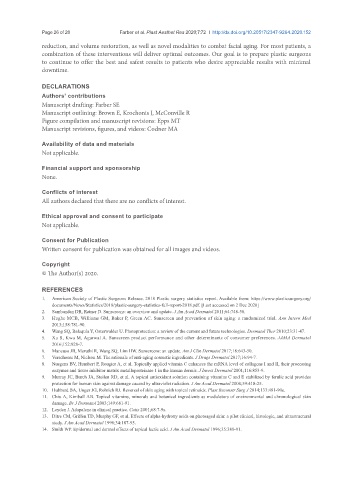Page 876 - Read Online
P. 876
Page 26 of 28 Farber et al. Plast Aesthet Res 2020;7:72 I http://dx.doi.org/10.20517/2347-9264.2020.152
reduction, and volume restoration, as well as novel modalities to combat facial aging. For most patients, a
combination of these interventions will deliver optimal outcomes. Our goal is to prepare plastic surgeons
to continue to offer the best and safest results to patients who desire appreciable results with minimal
downtime.
DECLARATIONS
Authors’ contributions
Manuscript drafting: Farber SE
Manuscript outlining: Brown E, Krochonis J, McConville R
Figure compilation and manuscript revisions: Epps MT
Manuscript revisions, figures, and videos: Codner MA
Availability of data and materials
Not applicable.
Financial support and sponsorship
None.
Conflicts of interest
All authors declared that there are no conflicts of interest.
Ethical approval and consent to participate
Not applicable.
Consent for Publication
Written consent for publication was obtained for all images and videos.
Copyright
© The Author(s) 2020.
REFERENCES
1. American Society of Plastic Surgeons Release. 2018 Plastic surgery statistics report. Available from: https://www.plasticsurgery.org/
documents/News/Statistics/2018/plastic-surgery-statistics-full-report-2018.pdf. [Last accessed on 2 Dec 2020]
2. Sambandan DR, Ratner D. Sunscreens: an overview and update. J Am Acad Dermatol 2011;64:748-58.
3. Hughe MCB, Williams GM, Baker P, Green AC. Sunscreen and prevention of skin aging: a randomized trial. Ann Intern Med
2013;158:781-90.
4. Wang SQ, Balaqula Y, Osterwalder U. Photoprotection: a review of the current and future technologies. Dermatol Ther 2010;23:31-47.
5. Xu S, Kwa M, Agarwal A. Sunscreen product performance and other determinants of consumer preferences. JAMA Dermatol
2016;152:920-7.
6. Mancuso JB, Maruthi R, Wang SQ, Lim HW. Sunscreens: an update. Am J Clin Dermatol 2017;18:643-50.
7. Verschoore M, Nielson M. The rationale of anti-aging cosmetic ingredients. J Drugs Dermatol 2017;16:94-7.
8. Nusgens BV, Humbert P, Rougier A, et al. Topically applied vitamin C enhances the mRNA level of collagens I and II, their processing
enzymes and tissue inhibitor matrix metalloproteinase 1 in the human dermis. J Invest Dermatol 2001;116:853-9.
9. Murray JC, Burch JA, Steilen RD, et al. A topical antioxidant solution containing vitamins C and E stabilized by ferulic acid provides
protection for human skin against damage caused by ultraviolet radiation. J Am Acad Dermatol 2008;59:418-25.
10. Hubbard BA, Unger JG, Rohrich RJ. Reversal of skin aging with topical retinoids. Plast Reconstr Surg J 2014;133:481-90e.
11. Chiu A, Kimball AB. Topical vitamins, minerals and botanical ingredients as modulators of environmental and chronological skin
damage. Br J Dermatol 2003;149:681-91.
12. Leyden J. Adapalene in clinical practice. Cutis 2001;68:7-9s.
13. Ditre CM, Griffen TD, Murphy GF, et al. Effects of alpha-hydroxy acids on photoaged skin: a pilot clinical, histologic, and ultrastructural
study. J Am Acad Dermatol 1996;34:187-95.
14. Smith WP. Epidermal and dermal effects of topical lactic acid. J Am Acad Dermatol 1996;35:388-91.

